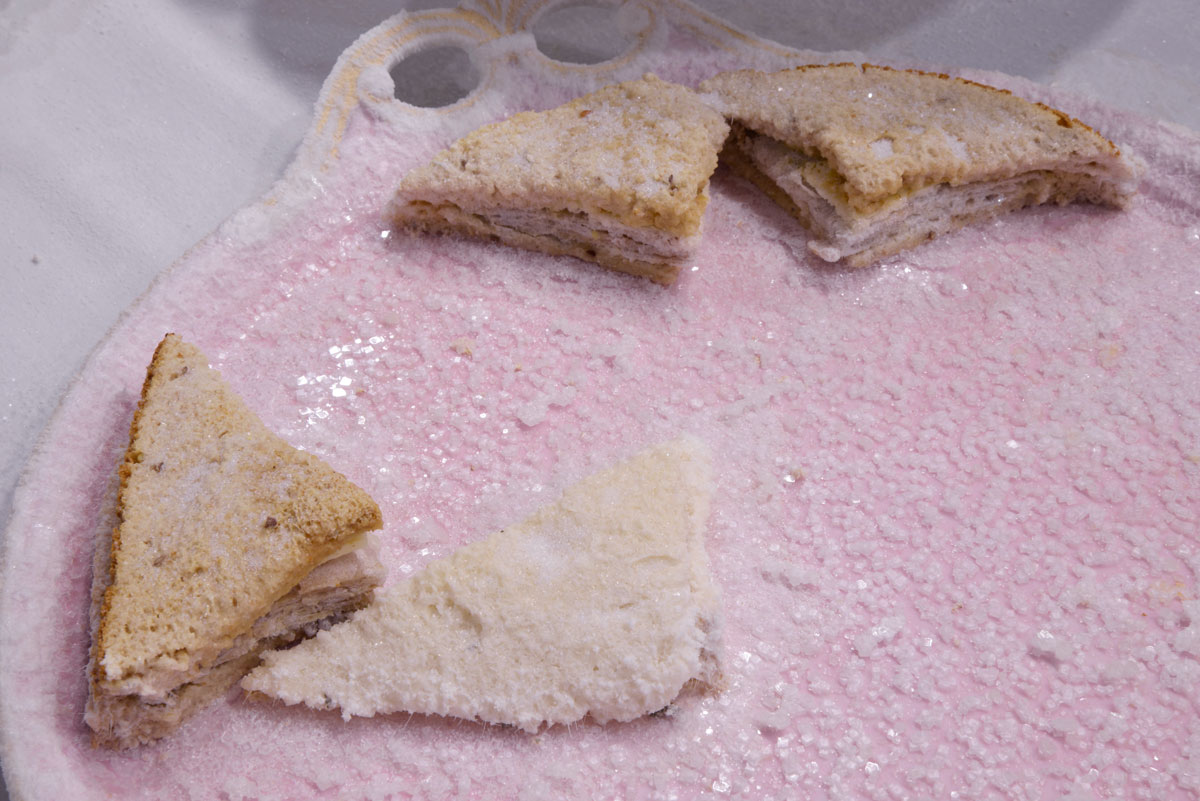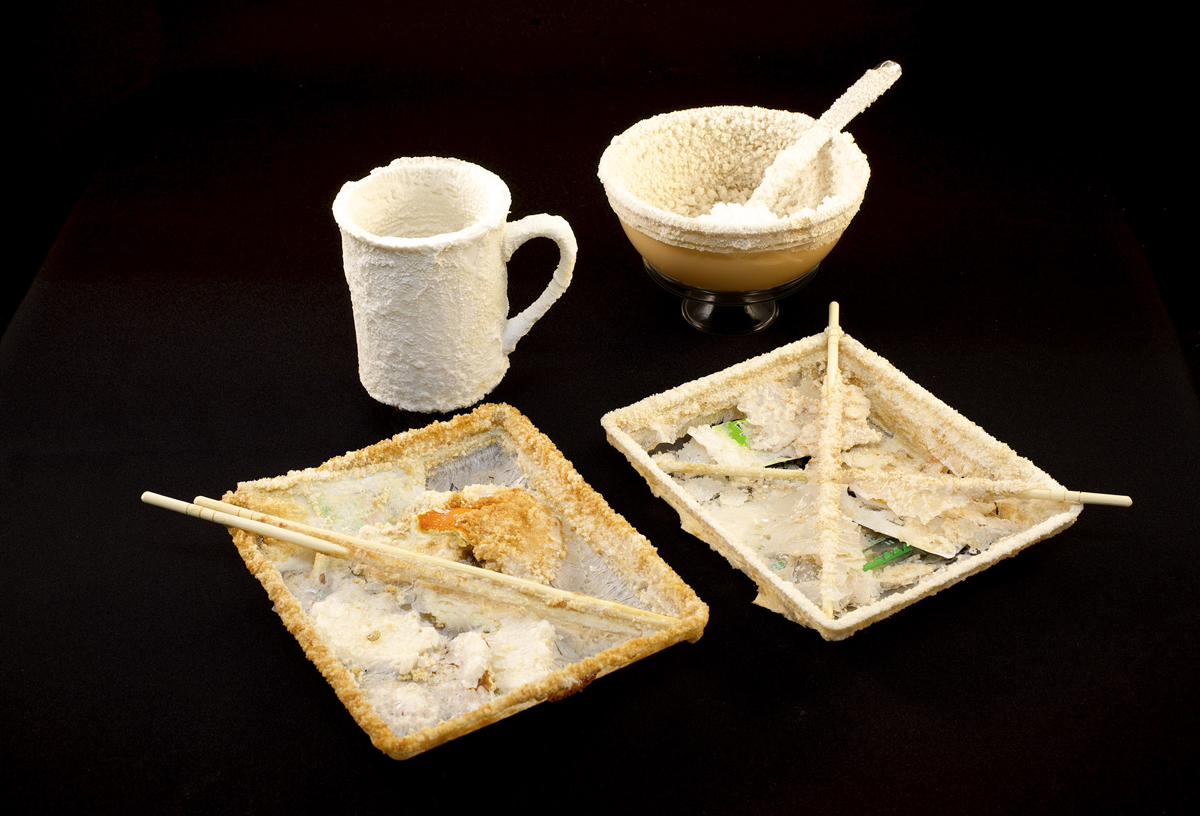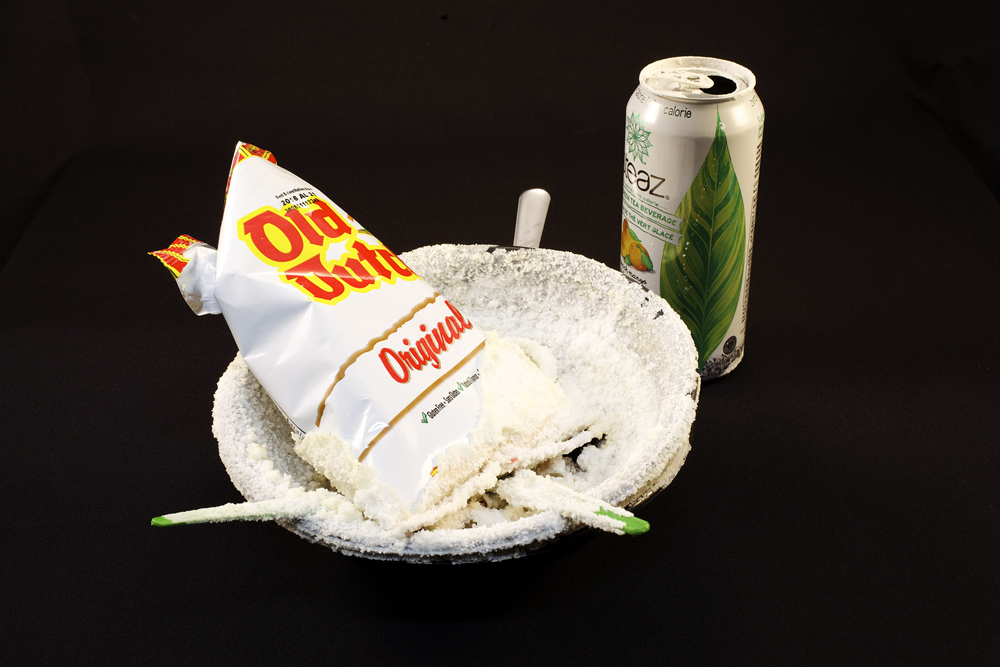Waking up after a raucous dinner party to a table strewn with half-cleaned plates and a sink filled with pots feels like a particular kind of penance. For most of us, there are few solutions beyond the obvious: start cleaning. Winnipeg artist Elvira Finnigan, though, has a different approach. Crystallize the entire thing, and turn it into an art installation.
For more than a decade, Finnigan has experimented with salt-brining objects. She hosts tea parties, feasts and school lunches before dousing the remains of the events with a supersaturated mixture and transforming the leftovers into glittering, crystalline installations.
 Elvira Finnigan, “Reception” (installation view), 2017. Courtesy Dunlop Art Gallery. Photo: Don Hall.
Elvira Finnigan, “Reception” (installation view), 2017. Courtesy Dunlop Art Gallery. Photo: Don Hall.
Late last year, Finnigan, along with artist Lisa Wood, turned Winnipeg’s Gallery 1C03 into a cafeteria. Plates of poutine and packages of sushi were served to students over lunch hour, and, once the crowd had been sated, Finnigan began her repetitive half-hour task of coating the objects, carefully pouring the brine over them. Ultimately, the glittering plastic trays and crushed disposable coffee cups went on view in an exhibition earlier this year, “Cafeteria II.”
Finnigan kicked off her show “Reception” at Regina’s Dunlop Art Gallery earlier this year with an opening event. The catch, of course, was that the remains of the dishware and food from the party would ultimately become the work itself.
 Elvira Finnigan, “Reception” (installation view), 2017. Courtesy Dunlop Art Gallery. Photo: Don Hall.
Elvira Finnigan, “Reception” (installation view), 2017. Courtesy Dunlop Art Gallery. Photo: Don Hall.
“In Manitoba and Saskatchewan in the ’50s it was very common to have a tea receptions for funerals or showers or what have you. Somebody would be at one end pouring tea and there would be a punch bowl and these little sandwiches, which we called dainties,” said Finnigan. “Now that kind of food is referred to as funeral food, and I always like that idea that I’m looking back to a way of doing things that isn’t necessary the way it’s done now.”
So Finnigan laid out these finicky foods, and transformed them over a series of weeks into a kind of memento mori of days past.
 Elvira Finnigan, “Reception” (installation view), 2017. Courtesy Dunlop Art Gallery. Photo: Don Hall.
Elvira Finnigan, “Reception” (installation view), 2017. Courtesy Dunlop Art Gallery. Photo: Don Hall.
Even when there’s an air of convivial nostalgia in Finnigan’s projects, a sense of sadness registers. Looking at her scenes, it appears that the objects have been abandoned and forgotten, rather than carefully laboured over. This is not an entirely surprising sensibility, given the series’ impetus. Her Saltwatch experiments, as she refers to the larger body of work, began in the wake of 9/11.
“I was living in Pittsburgh, where the last plane was flying over, and everybody was afraid that that last plane was going to hit some of the taller buildings between New York and Chicago,” said Finnigan. “I’ve never been in an environment before where you could taste the fear.”
 Elvira Finnigan, Fragments: sushi take-out tray, bowl with ball, cup, 2016. Courtesy Gallery 1C03.
Elvira Finnigan, Fragments: sushi take-out tray, bowl with ball, cup, 2016. Courtesy Gallery 1C03.
The images circulated after the tragedy captured Finnigan’s attention. “The New York Times was publishing a lot of images of common things that were covered in that dust,” she told me. “And the images were compelling—they had an ambiguity. They were monochromatic because of the dust and many of them were quite beautiful, but of course horrific because they resulted from this disaster.”
A little while later, Finnigan was cooking with sugar that began to crystallize, and she was quickly transported to memories of junior high–school experiments using salt. She had discovered her method.
That salt preserves is no surprise; any grocery store stocks cured hams or salted fish. But there’s a careful question of scale that Finnigan flirts with in these scenes: it’s one thing to extend the life of a single object—that’s practical. But it’s another thing to maintain a scene in its entirety. The latter is ominous. It is shipwrecks on the ocean floor and Pompeii and Lot’s wife turned into a pillar for her disobedience.
Finnigan’s alchemy reveals that even the most mundane of objects can be transformed into something beautiful and disastrous in equal measure.

 Elvira Finnigan, Fragments: bowl, chip bag, pop tin, 2016. Courtesy Gallery 1C03.
Elvira Finnigan, Fragments: bowl, chip bag, pop tin, 2016. Courtesy Gallery 1C03.







